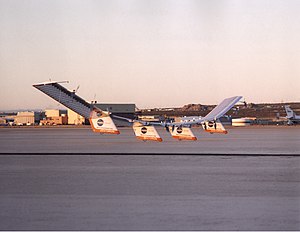NASA Centurion
| Centurion | |
|---|---|
 |
|
| Centurion takes off from Dryden in December, 1998 | |
| Role | Remote controlled UAV |
| Manufacturer | AeroVironment |
| Primary user | NASA ERAST Program |
| Number built | 1 |
| Developed from | NASA Pathfinder |
| Developed into | NASA Helios |
The NASA Centurion was the third aircraft developed as part of an evolutionary series of solar- and fuel-cell-system-powered unmanned aerial vehicles. AeroVironment, Inc. developed the vehicles under NASA's Environmental Research Aircraft and Sensor Technology (ERAST) program. They were built to develop the technologies that would allow long-term, high-altitude aircraft to serve as atmospheric satellites, to perform atmospheric research tasks as well as serve as communications platforms. It was developed from the NASA Pathfinder Plus aircraft and was developed into the NASA Helios.
Centurion, originally built for the 100,000 feet (30,000 m) altitude on solar power milestone specified by the ERAST project, was the third generation aircraft in the NASA Pathfinder series of electrical-powered flying wing unmanned aircraft. The ERAST program managers had determined that an aircraft based on the Pathfinder/Pathfinder Plus concept would be the lowest risk approach of achieving the altitude goal.
Initially, a quarter-scale model of the Centurion was test flown at El Mirage Dry Lake on March 4, 1997. The full-size Centurion's maiden flight took place at Rogers Dry Lake on November 10, 1998, and lasted a total of 1 hr and 24 minutes. At the time, it weighed in at 1,385 pounds (628.2 kg) (including a 150 pounds (68.0 kg) steel anvil hanging on its centerline to simulate a payload) for its first flight. The flight was nearly flawless and was followed by a second similar performance on November 19, this time before a crowd of VIPs and Media. It lasted 1 hr and 29 minutes. The third and final flight of the low altitude test series took place on December 3. On this flight the vehicle was loaded down to its maximum gross weight of 1,806 pounds (819.2 kg) to test its weight carrying capability. Total flight time on this flight was 30 minutes, as it was shortened because high winds were anticipated by mid-morning. All of these flights took place on battery power and verified the design's handling qualities, performance, and structural integrity. Following these three flights, NASA decided to expand the aircraft into the Helios Prototype, with work starting in January, 1999.
...
Wikipedia
